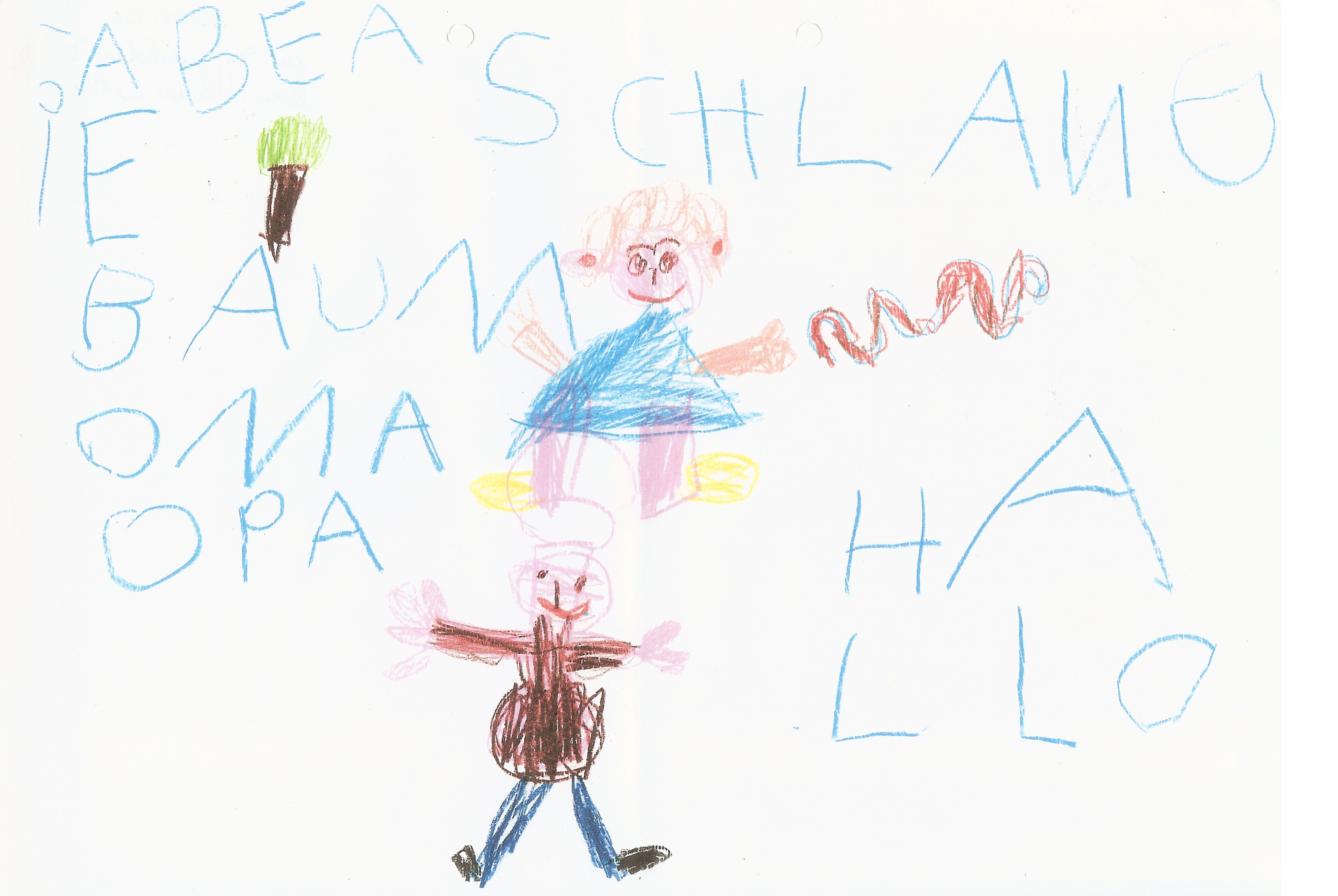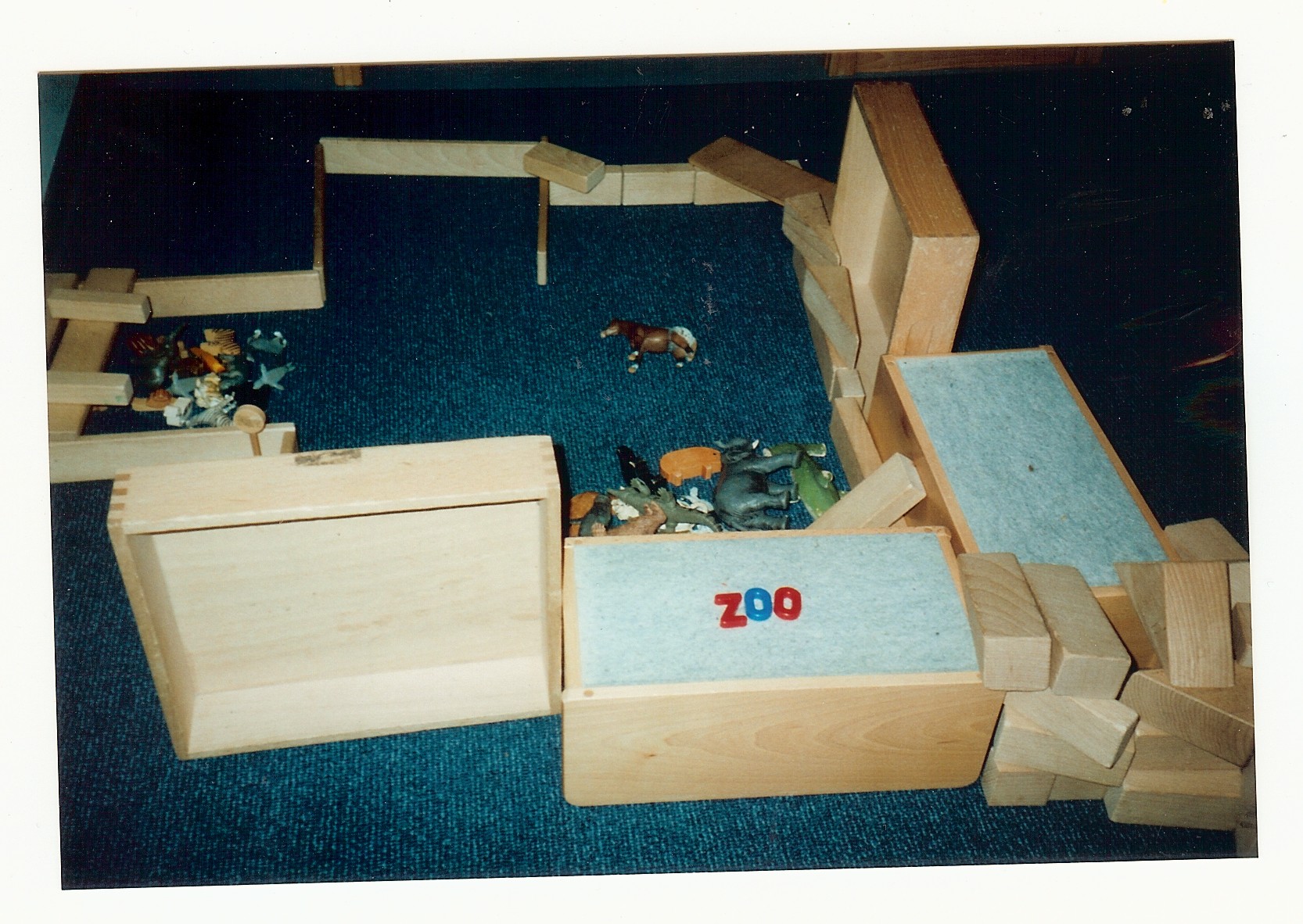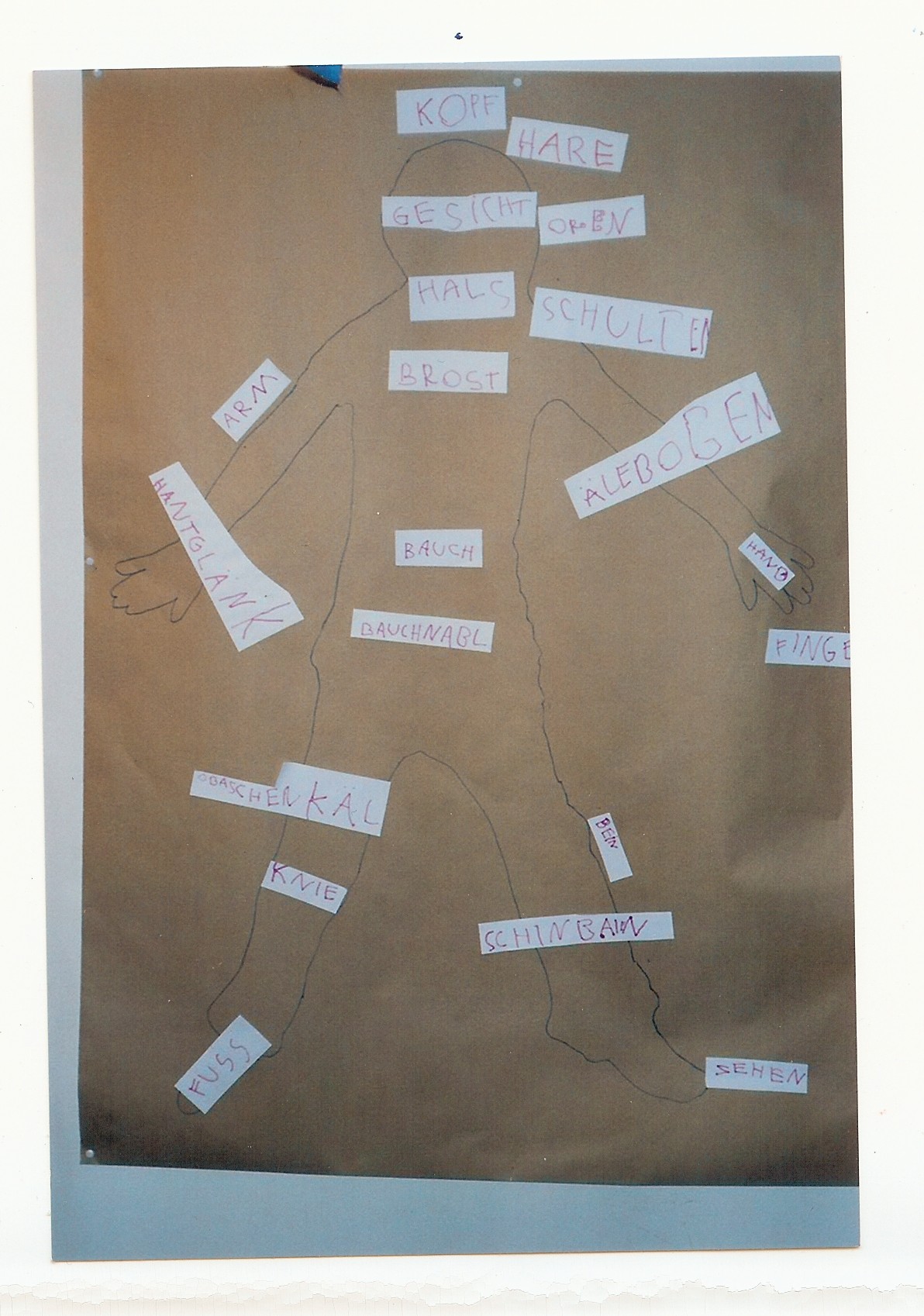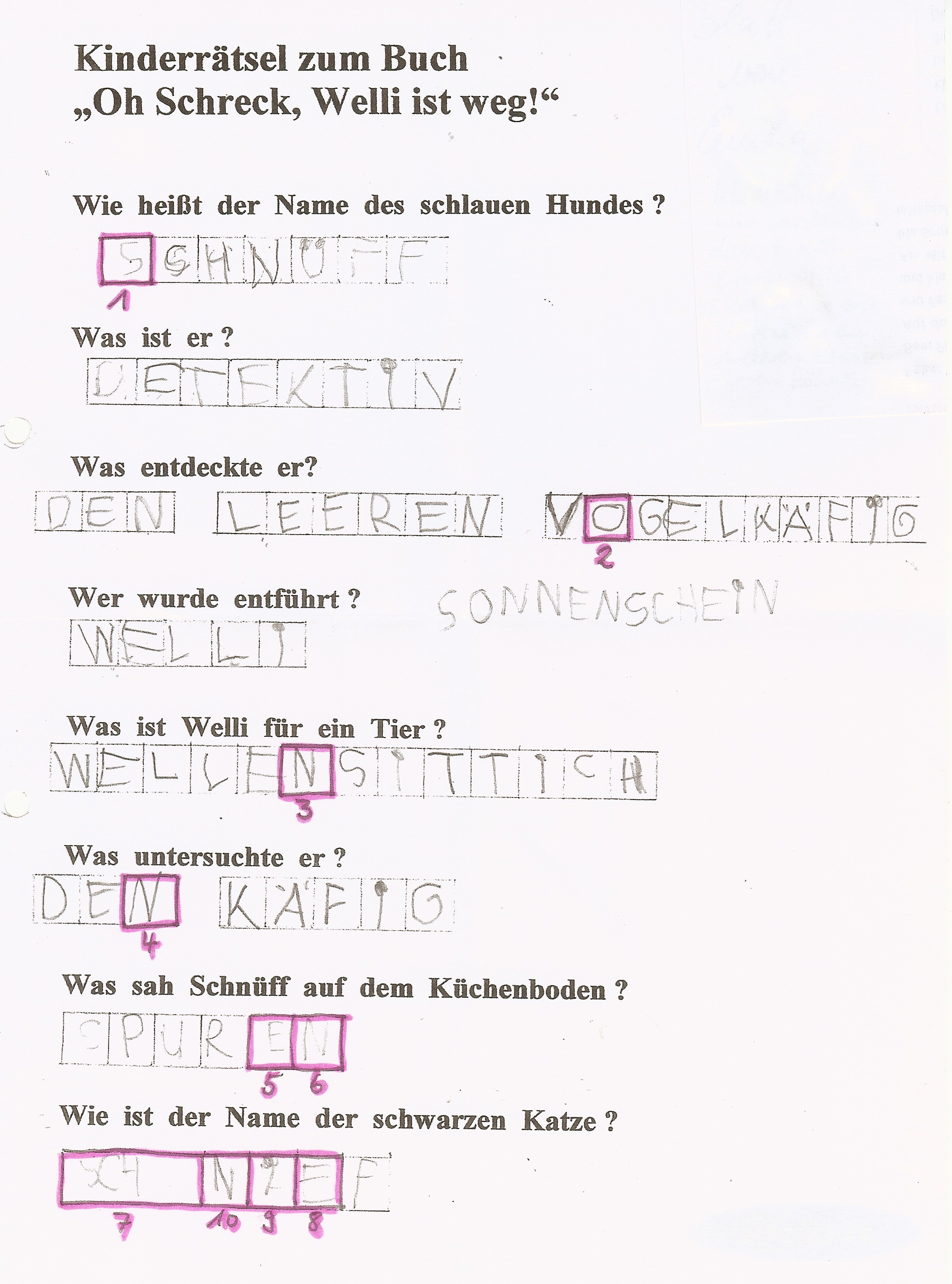von Antonia Herberg
Ich möchte Manuel (5;3) dabei helfen, sich eine andere Rolle in seiner Kindergruppe zu erarbeiten. Sehr oft ist er in der Rolle des Clowns und des Störers.
Mein Weg ist, ihm Situationen anzubieten, in denen er bei den anderen Kindern mit seinen Interessen und Fähigkeiten ankommt und seine positiven Potentiale zum Tragen kommen lässt. Auch hoffe ich ihn durch das Entstehen von Freundschaften zu stärken.
Manuel soll Möglichkeiten erhalten, seinem Forscherdrang und seiner Lernlust nachzugehen. Parallel dazu möchte ich ihm Wege zeigen, seine Dinge der Kindergruppe zugute kommen zu lassen, sich einzubringen, sich selbst und die anderen Kinder erleben zu lassen, dass er eine Bereicherung ist.
Dazu gehört das Angebot, dass er seine Ergebnisse im Stuhlkreis präsentiert. Es soll auch den Versuch geben, andere Kinder in sein Tun einzubeziehen.
Eine erste Beobachtung und Einschätzung von Manuel findet sich hier: Manuel, 5;0 Jahre.
1.
In den letzten Tagen hat sich Manuel (5;3) während des Freispiels wiederholt das (Montessori-) Angebot >Kerze anzünden< geholt. Seine Aufmerksamkeit galt dabei deutlich dem Moment, in dem er die Kerze mit dem Dochtlöscher ausmachte. Er tat dies jedes Mal sehr langsam und ließ die Kerze immer wieder aufflackern.
Um ihm eine neue Mögichkeit zu geben, das Verlöschen der Kerze zu beobachten, stelle ich ihm eine Kerze, Streichhölzer und ein Glas hin.
Als er sich am nächsten Morgen wieder die Kerze holt, frage ich ihn, ob ich ihm etwas anderes mit der Kerze zeigen darf. Manuel schaut mich aufmerksam an und stimmt zu. Ich demonstriere ihm einmal den Ablauf, Manuel lacht und wiederholt es gleich mehrmals. Dabei legt er den Kopf auf die Tischplatte und schaut so der Kerze beim Verlöschen zu.
Ich frage ihn, ob er weiß, warum die Kerze unter dem Glas ausgeht. Er antwortet: „Die kriegt keine Luft mehr.“ Ich biete ihm ein größeres Glas an. Er nimmt es und sagt: „Da hat sie mehr Luft.“ Manuel probiert es aus. Als ich ihm eine zweite Kerze hinstelle, zündet er beide an und stülpt die Gläser gleichzeitig beidhändig darüber und beobachtet gespannt, was geschieht.
Er fragt, ob ich auch noch ein ganz kleines Glas habe. Er baut seine Beobachtung bis auf fünf verschieden große Gläser aus, stellt sie der Reihe nach auf und stülpt mit raschen und koordinierten Bewegungen die Gläser darüber.
Nach mehreren Durchläufen strahlt er mich an und sagt: „Das macht so einen Spaß, ich werde alle Streichhölzer verbrauchen.“
Zum Ende des Freispiels bitte ich Manuel, doch den anderen Kindern im Stuhlkreis zu zeigen, was er gemacht hat, und es ihnen zu erklären. Er überlegt, lächelt und nickt.
Alle sitzen im Kreis, Manuel sitzt nben mir und vor ihm steht das Tablett mit den Kerzen, Gläsern und Streichhölzern. Die Kinder warten. Ich frage Manuel leise, ob er ihnen jetzt sagen kann, was er vorhat. Manuel schüttelt den Kopf, neigt sich zu mir und flüstert: „Du!“ Ich sage einige Sätze zu den Kindern und Manuel beginnt die Kerzen anzuzünden. Bevor er die Gläser darüberstülpt, schaut er ernst in die Runde und sagt : „Das muss jetzt zack-zack gehen.“ Seine Vorführung gelingt. Er erklärt noch, dass Feuer Luft braucht um zu brennen; dass verschieden viel Luft in den Gläsern ist und deswegen die Kerzen nacheinander ausgehen. Die Kinder sind aufmerksam, hören und schauen zu.
Ich bedanke mich bei Manuel und übergebe den Stuhlkreis an ein Vorschulkind. Dann verlasse ich den Raum und die Kinder spielen unter Anleitung des großen Jungen etwa 45 Minuten. Als ich wieder dazukomme, sehe ich Manuel mit zufriedenem und fröhlichem Gesicht in der Runde mitspielen.
Anmerkung der Kursleitung:
Er beginnt seine Erkenntnisse mitzuteilen. Und er erlebt Erfolg: zuerst bei seinen Untersuchungen, die ihn zu neuen Erkenntnissen führen, und dann den sozialen Erfolg, dass ihm die Kinder bei seiner Präsentation aufmerksam folgen. Das bringt gute Gefühle.
2.
Manuel wiederholt das Spiel mit den Kerzen und den Gläsern. Er agiert selbstständig und sehr konzentriert und macht mehrere Durchgänge. Sein Augenmerk liegt offensichtlich darauf, die Gläser in schnellem Tempo über die Kerzen zu stülpen, um Zeitgleichheit beim Start zu erreichen. (Diese Aufgabe hat er sich selber gestellt.) Manchmal geht dabei eine Kerze aus. Dann sagt Manuel „Mist!“ und beginnt noch einmal von vorne.
Manuel gegenüber sitzt der gleichaltrige Ole und arbeitet mit dem Elektrokasten. Nach einiger Zeit beobachtet Manuel Ole, dem sein Vorhaben nicht richtig gelingt. Manuel steht auf, geht um den Tisch herum, nimmt Ole den Schraubenzieher aus der Hand und baut einen Stromkreis. Dann setzt er sich wieder auf seinen Stuhl, schaut Ole an und sagt lächelnd: „So geht das.“ Sie unterhalten sich über ihre Arbeiten. Manuel steht nach einigen Minuten wieder auf, stellt sich neben Ole, holt dann seinen Stuhl, setzt sich und schaut Ole eine Viertelstunde lang schweigend zu. Dann räumen beide auf und gehen zusammen frühstücken. Sie unterhalten sich fröhlich darüber, was sie gerne essen.
Anmerkung der Kursleitung:
Da haben sich zwei Forscher und Tüftler gefunden!
3.
Manuel bekommt das Angebot, verschiedene Rohstoffe mit einem Mörser zu zermahlen. Er ist konzentriert bei der Sache und arbeitet über zwei Stunden daran. Er schaut immer wieder genau hin, was passiert, was sich im Mörser verändert. Im Stuhlkreis stellt er seine Arbeit souverän und sicher vor.
Anmerkung der Kursleitung:
Oh! Was für ein Fortschritt durch ein positives Ergebnis. Er hat das Präsentieren gelernt. Auch da zeigt sich Lernleichtigkeit.
4.
Auf dem Tisch stehen weiße Margeriten in einer Vase. Ich frage Manuel: „Meinst du, dass die Margeriten das Wasser trinken?“ Er nickt und sagt: „Ja, alle Pflanzen brauchen Wasser.“ Ich frage weiter, ob man sehen kann, dass sie es trinken. Manuel überlegt kurz und sagt: „Ja, mit einer Lupe.“ Ich gebe ihm eine Lupe und er betrachtet aufmerksam die Stängel durch die Lupe. Nach einiger Zeit frage ich ihn, ob er etwas beobachten konnte. Er schüttelt den Kopf und sagt: „Ich sehe nichts.“
Ich weise ihn darauf hin, dass das Wasser in der Vase durchsichtig ist, dass es keine Farbe hat, und schlage ihm vor, es zu färben, dann müssten die Blumen farbiges Wasser trinken. Er schaut mich an und fragt: „Was passiert dann?“ Ich frage zurück: „Was könnte passieren, was meinst du?“ Er berührt eine Blüte und sagt: „Wird die dann bunt?“ Ich fordere ihn auf, es auszuprobieren, und gebe ihm einen Ständer mit Reagenzgläsern sowie rote und schwarze Tinte.
Manuel füllt die Tinte vorsichtig ein und stellt jeweils zwei Margeriten in rote und schwarze Tinte. Dann setzt er sich davor, verschränkt die Arme und guckt die Blumen an. Nach zehn (!) Minuten kommt er zu mir und sagt mit klagendem Ton: „Da passiert nichts.“
Wir stellen den Ständer mit den Blumen auf die Fensterbank und ich lade ihn ein, jetzt etwas anderes zu tun und zwischendurch immer mal nachzuschauen.
Zu Beginn des Stuhlkreises frage ich Manuel, ob er den Kindern erklären will, was er mit den Blumen gemacht hat. Er lacht und sagt: „Ja, das will ich machen.“ Manuel erzählt den Kindern mit viel Mimik und lauter Stimme von seinem Experiment und dass er jetzt wartet, ob etwas passiert ist. Die Kinder hören noch aufmerksamer zu als bei seiner ersten Demonstration. Manuel spricht frei und beachtet mich gar nicht mehr.
Mitten im Stuhlkreis springt er auf und ruft: „Da, es fängt an! Eine Blume wird schon rosa.“ Manuel strahlt und alle Kinder schauen sich die rosa Blume an. Im Hinausgehen sagt er: „Schwarz dauert länger.“
5.
Das Mörsern interessiert Manuel weiterhin. Jeden Tag wird etwas anderes zerstoßen. Er hat die Ergebnisse wieder im Stuhlkreis vorgestellt und findet Gefährten, die diese Leidenschaft mit ihm teilen.
Anmerkung der Kursleitung:
Hier beginnt sich die Aufmerksamkeit, die Du Manuel gibst, für die Gruppe deutlich positiv auszuwirken.
6.
Manuel ist aus dem Urlaub zurück. Er steuert auf die Sandpapierbuchstaben zu und sagt: „Antonia, weißt du, dass ich jetzt ein wenig lesen kann?“
Ich antworte: „Nein, aber du könntest es mir zeigen.“ Er grinst und benennt bis auf zwei alle Buchstaben. Dann sagt er: „Ich will jetzt alle durchreiben und ein Buch damit machen.“ Er ist lange und konzentriert damit beschäftigt.
7.
Manuel beschäftigt sich immer wieder mit den Buchstaben. Er spricht von Geheimschrift und ich zeige ihm Spiegelschrift anhand meines Namens. Er ist begeistert und probiert viel aus. Unter anderem klebt er eine Druckplatte und freut sich über die verkehrte Schrift beim Drucken. Im Stuhlkreis erklärt er den Kindern die Spiegelschrift.
8.
Heute bastelt Manuel sich einen Umschlag aus Papier, schreibt etwas auf einen kleinen Zettel und steckt ihn in den Umschlag. Ich frage, ob ich es mal sehen darf. Er zögert und sagt dann entschlossen: „Nein, geht nicht. Ist ja geheim!“ Ich lache und sage: „Wie schade für mich.“ Manuel sagt tröstend: „Macht nix. Du könntest es eh nicht lesen, weil es Geheimschrift ist.“ Dann bringt er es in seine Schublade und sagt im Weggehen: „Geheim kann man auch nicht im Stuhlkreis zeigen“ und lacht wieder.
Anmerkung der Kursleitung:
Jetzt kann er schon frei entscheiden, was er Dir und den anderen Kindern präsentieren will und was nicht. Wieder ein Lernfortschritt.
9.
Manuel arbeitet jetzt öfter mit anderen Kindern, heute mit Ole zusammen. Mit geometrischen Formen in Größenabstufung erfinden sie Muster, arbeiten die Formen mit buntem Papier nach und kleben ihre „Erfindung“ auf.
10.
Manuel kommt morgens rein und sagt: „Ich weiß, was ich machen will. Ich wollte schon immer mal am liebsten auf der Welt einen Webrahmen machen.“ Wir spannen einen Webrahmen für ihn. Er hat es schnell raus, webt ausdauernd und lässt sich auch bei Fehlern nicht beirren. Er holt sich dann Hilfe und macht weiter. Er wählt die Farben sorgfältig aus, indem er sie an das schon gewebte Stück hält.
11.
Manuel und Hans haben in den letzten Tagen öfter zusammen gearbeitet. Heute gehen sie morgens zielstrebig aufeinander zu und verabreden sich für den Bauraum. Emil fragt, ob er auch mitmachen kann. Hans und Manuel bauen ein Schienennetz mit der Brio Bahn. Emil spielt daneben alleine mit einer Lok und Anhängern. Manuel und Hans reden miteinander und stellen einander ihre Pläne und Aktionen vor. Manuel sagt: „Ey, wann verbinden wir die Schienen endlich, zum Donnerwetter?“ Hans und Emil lachen und schleudern die Bahngleise durch den Raum. Manuel: „Hey, warum macht ihr alles kaputt? So geht das nicht. Ich brauche eine lange Bahn. Wann binden wir endlich?“ Die beiden anderen Kinder werfen weiter alles durcheinander und lachen. Manuel regt sich auf und schimpft und ruft: „Stopp! Das wird nix!“ Als die zwei nicht reagieren, beginnt er heftig alles Gebaute umzuschlagen.
Anmerkung der Kursleitung:
Die Verzweiflung des Hochmotivierten, wenn Andere die Aufbauarbeit torpedieren.
Ich habe eingegriffen und Hans und Emil aufgefordert, Manuel zuzuhören. Das tun sie, und Manuel schildert sein Vorhaben. Sie bauen neu auf. Ich lade sie ein, die Loks alle mit Anhängern zu versehen. Manuel probiert, verteilt, ordnet wieder um und sagt: „Oh Mist, ich wollte eine mit vier Anhängern. Aber das geht nicht. Dann habn zwei Loks gar keinen.“
Er hantiert eine Weile. „Ich hab´s! Jede bekommt erstmal einen.“ Er macht es so, schaut und kommentiert: „So ist es gerecht.“ Sie beginnen zu spielen. Manuel kommentiert seinen fahrenden Zug: „Längste Strecke fahren. Oh, Station vergessen! Bahnhof! Anhalten! Der Nächste bitte! Der Nächste bitte!“
Anmerkung der Kursleitung:
Gut, dass Du ihm geholfen hast. Er lernt: Ich habe eine Idee, ein Vorhaben im Kopf. Wenn ich möchte, dass Andere mitziehen, muss ich sie ihnen vorstellen und erklären.
12.
Manuel kommt morgens herein und sagt: „Ich muss mal nach meinem Blatt sehen. Ich bin schon sehr gespannt.“ Vor einigen Tagen hat er von seinem Weg in den Kindergarten ein großes Blatt mitgebracht und in die Blumenpresse eingespannt.
Das Blatt ist noch nicht trocken. Er betrachtet und befühlt es und sagt: „Meinst du, es wäre fertig?“ Als ich verneine, sagt er: „Dann muss es wieder rein“ und spannt es erneut ein.
Anmerkung der Kursleitung:
Er zeigt wirklich gute Anlagen zum Forschen, zum Beispiel beständiges Interesse und Beharrlichkeit bei seinen Vorhaben.
13.
Manuel kommt gut gelaunt im Kinderhaus an. Er geht zu seinem Arbeitsplatz vom Vortag, um mit der angefertigten Druckplatte seinen Namen zu drucken. Er wählt die Farben, rührt sich einen Farbton an und trägt die Farbe mit der Walze gleichmäßig auf. Er druckt zum ersten Mal, schaut das Ergebnis an, lacht und ruft erfreut: „Alles verkehrt!“ (Spiegelschrift.)
Er fertigt mehrere Drucke an, räumt dann seinen Arbeitsplatz auf und schlendert durch die Gruppe.
14.
Manuel setzt sich an den Falt-Tisch und beginnt zu falten. Ich frage ihn, was er faltet. Manuel: „Ich falte einfach mal. Mal sehen, was dabei heraus kommt.“
Sehr konzentriert probiert er aus. Es entsteht ein regelmäßiges Faltwerk, bei dem alle Faltungen sich rechts und links entsprechen. Hans kommt und schaut ihm zu. Dann falten sie beide „einfach drauflos“ und zeigen sich gegenseitig ihre Ergebnisse.
Manuel hält seins hoch und sagt: „Sieht aus wie ein Flieger. Ich muss es ausprobieren.“ Der Probeflug gefällt ihm und er wiederholt den Faltvorgang in einer anderen Farbe. Dann räumt er auf und geht frühstücken.
Danach holt er zielstrebig seinen Webrahmen, hält ein Wollknäuel an das gewebte Stück, murmelt etwas, legt die Wolle weg und nimmt rote Wolle. Wieder hält er sie an das Gewebte, sagt „ja, gut“ und beginnt damit zu weben. Seine Bewegungen sind entspannt und konzentriert. Er schaut nicht, was um ihn herum geschieht.
15.
Immer wieder verlangt Manuel danach zu mörsern. Es erscheint fast wie ein Ritual des Ankommens. Immer stößt dann auch ein anderes Kind dazu und sie erfreuen sich gemeinsam an dieser Aktion.
16.
Manuel schaut zu, wie ich einem gleichaltrigen Jungen etwas mit brauner Treppe und roten Stangen (Montessori-Material) zeige. Er gibt Ratschläge zur Konstruktion. Mit dem Einverständnis von Konrad spielt er mit und sie probieren mit viel Spaß allerlei aus. Das gemeinsame Spiel zieht sich über den gesamten Vormittag.
Als Manuel ankommt und ich ihn begrüße, frage ich: „Wie sieht es aus? Was mörserst du heute?“ Manuel antwortet: „Nee, heute ist mal Schluss mit mörsern. Heute will ich mit Konrad in den Bauraum.“ Sie verschwinden im Bauraum und sind dort über den ganzen Vormittag guter Dinge, bauen eine große Eisenbahnanlage auf.
18.
Manuel übernimmt beim Rollenspiel im Stuhlkreis die Rolle des Wolfes in „Der Wolf und die sieben Geißlein“. Er spielt engagiert und mit den richtigen Einsätzen. Als die Geißlein zum Schluss singend um den Brunnen tanzen, in den Wolf Manuel gefallen ist, springt er auf und rennt zu seinem Platz.
Wir unterhalten uns im Stuhlkreis darüber, wie es uns gefallen hat. Ich frage Manuel, was mit dem Wolf im Brunnen plötzlich los war. Manuel sagt: „Ich fand diese Sache doof. Ich will nicht tot sein.“
19.
Manuel spielt mit der vierjährigen Mira. Er baut mit den (Montessori-) Stangen einen Rhombus und zeigt ihn der Erzieherin. Sie macht einen neuen Vorschlag. Manuel sagt: „Nein, ich will etwas anderes.“ Er erklärt mit Händen und Worten, welche Form das Gebaute haben soll. Die Erzieherin fragt: „Wie ein Trichter?“ Er strahlt: „Genau, wie ein Trichter!“
Sein Plan gelingt und er tanzt mit Mira begeistert um sein Werk herum.
Reflektion
Manuel hat unsere Unterstützung dabei bekommen, viel zu experimentieren und sowohl neue Dinge im Kinderhaus auszuprobieren, als auch Materialarbeit zu vertiefen und auszubauen.
Unsere Unterstützung bestand darin
-
- für ihn Angebote vorzubereiten, von denen wir annahmen, dass sie ihn interessieren,
- auf seine Vorgaben und Ideen einzusteigen und ihm zur Verfügung zu stehen, wenn er sie umsetzte.
Mehrfach präsentierte er seine Arbeit dann im Stuhlkreis. Die Gruppe reagierte darauf mit Neugier und Anerkennung. Es fanden sich Nachahmer seiner Tätigkeit, denen er dann mit Rat und Tat zur Seite stand, und auch andere Kinder präsentierten dann ihre Dinge im Stuhlkreis.
Inzwischen gehört diese Form der Darstellung zum alltäglichen Vorkommen und bereichert das Gruppenleben.
Zunehmend entwickelten sich Spielsituationen, in denen Manuel gut mit gleichaltrigen und auch deutlich jüngeren Kindern agierte. Seine Grundstimmung, die er im Kinderhaus zeigte, veränderte sich in einem erstaunlich schnellen Tempo. Er kommt nun voll Tatendrang und fröhlich in den Kindergarten.
Die Clownsrolle übernimmt er so gut wie nie mehr, sondern agiert sehr humorvoll, mit viel Witz und Freude an Situationskomik.
Er beteiligt sich aktiv an den Stuhlkreisangeboten. Als Spielpartner ist er inzwischen bei den Kindern gefragt.
Seit einigen Wochen ist Manuel auch über Mittag im Kinderhaus und kann in der kleineren Gruppe am Nachmittag noch einmal intensiv mit anderen Kindern zusammen spielen. Wir hatten der Mutter nahe gelegt, diesen Schritt auszuprobieren, weil in Elterngesprächen deutlich geworden war, dass Manuel zu Hause (er hat auch noch drei Geschwister) mit vielen Kämpfen die Familie und sich selber strapazierte.
Er hat die Übermittagsbetreuung mit Begeisterung aufgenommen. Das finde ich deswegen nicht selbstverständlich, weil sein jüngerer Bruder immer vor ihm abgeholt wird und zu Hause zu Mittag isst.
Manuel hat in dieser Zeit der gezielten Anforderungen und Zuwendung durch Angebote seine emotionale Befindlichkeit und seine soziale Stellung in der Gruppe stabilisieren können und an selbstbewusstem Auftreten gewonnen.
Konflikte werden von ihm entspannt und angemessen ausgetragen.
Zu den Erzieherinnen hat er ein deutlich freundschaftliches Verhältnis, das manchmal fast komplizenhaften Charakter hat
Anmerkung der Kursleitung:
Nun ja, das ist das Beste, was besonders begabten Kindern passieren kann.
Weitere Überlegungen
In den letzten zwei Wochen habe ich mich zunehmend zurück gezogen, eine Kollegin (die das IHVO-Zertifikat bereits hat – siehe auch: Journalismus im Kindergarten) hat im Laufe der Wochen auf sehr kompetente Weise seine Begleitung übernommen. Zu diesem Schritt hat mich die Notwendigkeit des Alltags (Zuwendung zu anderen Kindern) bewogen, zum anderen auch der Eindruck, es sei nun der richtige Zeitpunkt gekommen, Manuel häufiger seinen eigenen Weg weiter gehen zu lassen. Dadurch will ich vermeiden, dass er sich nur dann als gut erlebt, wenn er dicht am Erwachsenen agiert. Es ist mir ein wichtiges Anliegen, in meiner Aufmerksamkeit für ihn nicht nachzulassen – aber in der gelebten Zuwendung die richtige Balance zu finden, damit Manuel sich weiter als Mitglied dieser Kindergruppe erlebt und verhält und seine Unabhängigkeit wächst.
Ich bin zuversichtlich, dass uns das als Erzieherinnen-Team gelingen wird und dass Manuel mit seinem neuen Startkapital an Kompetenz weitere positive Entwicklungsschritte machen kann.
Sehr beeindruckt hat mich bei diesem Projekt das Ausmaß des Profits für die anderen Kinder. Einige Kinder haben zunächst nachahmend, aber dann doch ihren eigenen Bedürfnissen entsprechend, neue Spielformen für sich eingefordert und auch wieder der Gruppe zunutze gemacht.
Wir Erwachsenen haben während dieser Zeit viel Neues für unsere Arbeit mit den Kindern im allgemeinen und auch konkret mit Manuel entdecken können. Der nächste Schritt für mich wird sein, genau hinzuschauen, wann Manuel neues Input braucht und wo er alleine weiter kommt. Manuel steigt so begeistert auf alle Anregung ein, dass man sich als Erwachsener vielleicht in die Gefahr begibt, in die Rolle des Animateurs zu rutschen. Das möchte ich bei mir selbst beobachten und reflektieren.
Anmerkung der Kursleitung:
Die Gefahr, dass Du zur Animateurin werden könntest (also ihn nur zu unterhalten und zu „bespaßen“) sehe ich bei Dir nicht. Manuel setzt ja jede Anregung sehr selbstständig um und hat auch eigene Ideen… Je mehr er davon (mit Unterstützung, auch durch weiter führende Fragen; wo es sinnvoll ist) erfolgreich umsetzen kann, desto mehr gute Ideen wird er produzieren.
Sehr oft kommt Manuel morgens in das Kinderhaus und hat einen eigenen Plan im Kopf und weiß, was er gerne tun möchte. Ich will ihm die dazu nötigen Mittel zur Verfügung stellen und ihn so unterstützen, seinen eigenen Entwicklungsplan, seine eigenen Lernwege in und mit der Gruppe zu verfolgen.
Alle Kindernamen wurden verändert.
Datum der Veröffentlichung: April 2020
Copyright © Antonia Herberg, siehe Impressum.






